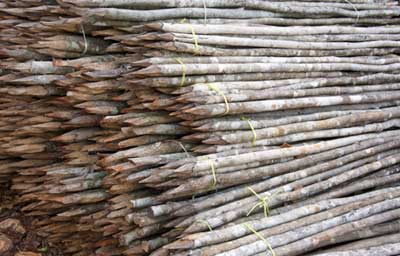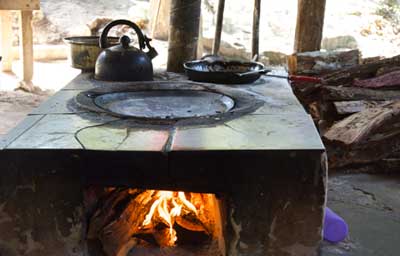Estufas ahorradoras de leña

La manera tradicional de cocinar en las comunidades mayas de la Península de Yucatán es colocando tres piedras en el suelo a modo de soporte, se enciende el fuego en el centro y encima se coloca la comida. Este tipo de cocina, conocida como K´óoben en maya yucateco, se utiliza dentro de la casa, y el humo va cubriendo de hollín el huano con que está construido el techo, lo cual elimina insectos y le da mayor vida útil al material. Pero también provoca problemas respiratorios severos, principalmente en la mujer que es quien más horas pasa alrededor de la cocina. En ese contexto, la asociación civil U’yo’olché inicia el proyecto Túumben K’óoben, que significa “nuevo fogón” en maya. El objetivo es la construcción de estufas ahorradoras de leña en comunidades de la Península de Yucatán, las cuales permiten controlar la emisión de humo dentro de los hogares. Otro aspecto importante es el ahorro de leña, ya que los miembros de la familia tienen que ir muy seguido al “monte” por este recurso, el cual empieza a escasear en algunas comunidades. Con la estufa ahorradora, la búsqueda de leña se realiza cada dos o tres semanas, y ello reduce el esfuerzo y también la presión sobre el recurso. Con este proyecto, U’yo’olché ha desarrollado una tecnología que propone ser económicamente sostenible por medio de una cooperativa, utilizando materiales de la región y adaptando aspectos técnicos al entorno cultural de cada comunidad.
La idea del proyecto surgió durante un taller sobre captura de carbono, en el que un investigador originario de Michoacán habló sobre estrategias para luchar en contra del cambio climático y enseñó una foto de una estufa ahorradora de leña. En el taller había personas de Felipe Carrillo Puerto, y fueron ellos quienes pidieron que se construyera una en la comunidad. Se construyó la primera estufa en un vivero ejidal, y la tecnología llamó mucho la atención. Un primer aprendizaje fue que el modelo construido (Patsari) y los materiales usados no adecuados para la región. Un ejemplo de ello, es la ausencia de barro en la Península de Yucatán, lo cual hace que usar tabiques resulte muy costoso. Además, el modelo usado no era adecuado a las formas de cocinar en el trópico. Este constituye una barrera inicial muy fuerte para garantizar la adopción de la tecnología. Por ello, se decidió desarrollar de forma participativa una estufa ahorradora de leña adecuada. Para lograrlo, se convocaron a talleres con albañiles (constructores) y cocineras (usuarias), a quienes se les solicitó imaginarse los diferentes componentes de la estufa. Con esas ideas, se crearon prototipos, que volvieron a ser evaluados por los mismos actores, hasta llegar a un consenso sobre la tecnología “óptima”. Así nació el modelo Túumben K´ooben, el cual cuenta con dos comales grandes, y está construido con los mismos materiales con los cuales se construyeron las pirámides. Esta mezcla de materiales locales (sascab, cal, etc.) permite la autoconstrucción en el hogar y una fácil reparación en caso de daño. Después de esta etapa, U’yo’olché continuó con la evaluación y mejoramiento paulatino de la estufa Túumben K´óoben para poder obtener un modelo perfectamente adecuado a las condiciones de la zona maya. “En el 2006, cuenta Dulce Magaña, coordinadora del proyecto, nos dimos a la tarea de revisar las estufas que ya existían en la región, de identificar las que nunca fueron usadas, las que fueron abandonadas y algunas demolidas. En el monitoreo identificamos 600 estufas que están funcionando, algunas con 9 años de uso. Si se le da mantenimiento la estufa sigue funcionando. Pero era importante comprender qué había pasado con el programa en los casos en que se abandonaron”.
El primer programa de gran escala de Túumben K’óoben fue en 2006, y la comunidad de Uh-May fue una de las primeras beneficiarias. “En ese programa las estufas se regalaban, y un gran porcentaje nunca se utilizó, se echaron a perder”, cuenta Dulce. “En aquellos años no teníamos presupuesto para dar seguimiento y las cocinas eran construidas cerca del chiquero, a la intemperie, en lugares alejados del uso diario. Esas estufas no funcionaron, y entendimos que la estufa tiene que estar en la cocina. Algunas personas también abandonan la estufa en los primeros días, cuando todavía no han aprendido a usarla”. Doña María Magdalena, beneficiaria de una estufa en Uh-May, explica que aprender a usar la estufa lleva tiempo. Las primeras veces es dificultoso porque la estufa todavía está húmeda, pero el mismo fuego ayuda a ir secando su interior. “Yo sufrí mucho, cuenta María Magdalena, se despedazaba la tortilla y pensé que nunca podría cocinar así, pero en quince días todo cambió y hoy no la cambio por nada. “A mis vecinas les gusta porque aquí no se respira humo como sucede con el fogón tradicional de tres piedras”, a lo cual Dulce agrega que el problema del humo en la cocina maya es un tema importante en la salud. María Magdalena señala el techo y dice, “nada más de ver el huano en esa parte de cuando no tenía la estufa, está de color negro por el hollín, imagine cómo estarán los pulmones”. Su marido, don Fernando, aporta su comentario: “antes iba por leña con el triciclo cada dos o tres días, pero ahora la carga de un triciclo dura dos hasta tres semanas. Imagine, yo tengo que hacer 2 km para ir por leña, pero la gente de Carrillo Puerto tiene que hacer 7 km porque cada vez le queda más lejos”. En 2011 los programas de apoyo se redujeron debido a que el modelo de auto construcción y materiales locales propuesto por U’yo’olché no correspondía con los modelos de subsidios existentes. Pero conscientes de que el programa no podía detenerse, se creó una cooperativa que trajo aparejado cambios muy importantes. La cooperativa trabaja con un fondo revolvente para materiales, construcción y mantenimiento, y las usuarias se comprometen a pagar con facilidades de pago. “Esto permite seguir incluyendo a más beneficiarias, pero no es fácil que la gente quiera pagar cuando en otras partes hay programas subsidiados por el gobierno”, explica Dulce, “pero este fue un momento clave, la gente que construye la estufa es porque realmente está convencida, se apropia porque puso recursos, y desde entonces no hemos vuelto a tener casos de estufas que se abandonan”. El equipo de Túumben K’óoben entiende que la economía de las comunidades atraviesa por muchas dificultades y que el costo de la estufa es relativamente elevado, pero cuando las beneficiarias no pueden pagar sus cuotas se trata de conseguir cofinanciamientos. La figura de la promotora también fue clave en el proyecto. Una promotora es una mujer líder de la comunidad que da seguimiento, motiva, organiza eventos, explica cómo ha mejorado su salud y muestra su cocina a quien quiera aprender. Es el caso de Doña Ana Pat Caamal, promotora en Felipe Carrillo Puerto, que lleva nueve años con su cocina abriendo las puertas a quien quiera conocer su experiencia. “Una de las primeras cosas que cuento, dice Doña Ana, es que antes de tener la estufa vivía engripada, con problemas respiratorios, y hoy ya no tengo ni recuerdos de esas gripes”.
 Lecciones aprendidas “Lo regalado no es bien valorado”, menciona Dulce como uno de los aprendizajes. “Hemos llegado a un sistema de microcréditos en el que participa la gente que realmente quiere la estufa, que la valora y la usa. Los microcréditos se pagan con cuotas muy bajas, y damos incentivos como las ollas solares para quienes terminan de pagar antes de los seis meses, lo que ha funcionado muy bien”. Las estufas que no fueron usadas desde un principio no fueron construidas en el lugar adecuado, o con los materiales adecuados, y no hubo capacitación ni seguimiento. “Antes no se daba el seguimiento que hacemos ahora con Túumben K’óoben, y es muy necesario enseñar a usarla”. Dulce comenta que para eso diseñaron un manual y dan una explicación al momento de la entrega. La pregunta es ¿cómo pagar el seguimiento, la capacitación constante y el mantenimiento? “Para esto no alcanza con los fondos revolventes que implementamos en la cooperativa. Es necesario buscar cofinanciamientos, como por ejemplo este año que entramos en un programa de certificación para la venta de bonos de carbono a través de emisiones evitadas con las estufas ahorradoras de leña”. Algo fundamental es convivir con la gente, entender sus necesidades e ir haciendo modificaciones para adaptarse al entorno cultural. Por ejemplo, en esta zona vive gente que ha llegado desde Tabasco, Campeche y Veracruz, todos ellos cocinan de pie, pero la gente maya cocina en banquillos casi a la altura del suelo. “Esto que parece un detalle es en realidad importantísimo, explica Dulce, porque al principio todas las estufas eran para cocinar de pie, no sabíamos que implicaría un cambio cultural grande. Hoy ofrecemos la posibilidad de hacer una estufa a la altura del suelo, es opcional”. Pasó algo similar con el hecho de que la estufa ahorradora elimina el humo dentro de la casa, y tiene que ver con una cuestión de seguridad alimentaria. En la zona maya no se usa refrigerador, es muy común que la gente cuelgue una canasta para ahumar encima de donde cocina, y ahí coloca tortillas, chile, semillas, y a veces una lonja de cerdo durante ocho meses para que se conserve. La solución es que tengan la opción de quitar el comal y ahumar. Si la señora estará en la cocina, coloca el comal y el humo se va por la chimenea, pero si va a salir puede dejar la estufa encendida con el comal abierto para ahumar. Dulce cuenta que se siente muy contenta con los resultados del proyecto y con lo que ha aprendido. “Una estufa involucra otros temas importantes como entorno familiar, empoderamiento de la mujer, felicidad, entre otras cosas. ¿Cómo mides felicidad? Una familia cambia su vida con una estufa, y el mejor indicador de que el proyecto funciona es cuando llegamos a los hogares y vemos que la gente está contenta compartiendo su experiencia”. El proyecto está ahora explorando nuevos enfoques para crecer. Por ejemplo, si bien se conoce de manera precisa los beneficios de la tecnología a nivel hogar, se sabe poco sobre el impacto sobre el macizo forestal, el medio ambiente, y el cambio climático. En la Península de Yucatán, la leña sigue siendo la principal fuente de energía en las comunidades rurales, y ya se están presentando casos de escasez del recurso en algunas regiones con fuerte deforestación o con presión demográfica importante. Para ello, el equipo del proyecto Túumben K´óoben se alió con científicos de la UNAM para investigar el tema de la extracción, y modelas escenarios futuros en cuanto a disponibilidad del recurso. Con estos resultados, se podrán proponer políticas públicas adecuadas, con un enfoque de degradación evitadas, pero también para permitir lograr la seguridad energética para las comunidades. Además, el equipo propone complementar la instalación de estufas de leña con estrategias locales y adaptadas de manejo del recurso, como es el manejo de T’olché o la reforestación de especies dendroenergéticas. |






















